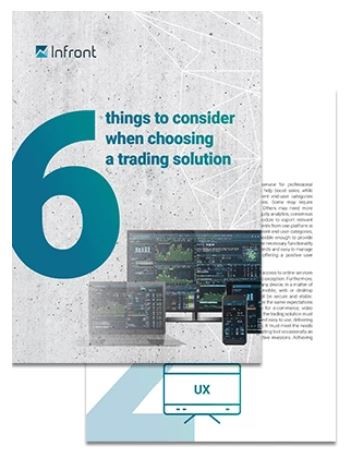Trading tools in the banking sector: Between cost pressure and customer wishes

The past year has given clients ample opportunity for active trading. Stock markets, commodity prices and alternative investments such as crypto assets alternated between record prices and market corrections.
2022 could be even more marked by active investors and bank customers. With the announcement of the first interest rate hikes and the end of the ultra-loose monetary policy, the U.S. Federal Reserve has probably put an end to the decades-long bull market on the bond markets. How long inflation rates will remain at the current high levels is disputed and will lead to different allocation decisions by investors. Other major risks include the flare-up of geopolitical crises in Taiwan and Russia’s latest attack on Ukraine, which lead to high volatility in the capital markets. Finally, commodity prices are also likely to remain in flux, driven not least by regulatory efforts to channel capital into sustainable energy production.
These and other trends mean above all that bank customers - whether wealthy private bank customers or equity savers at a retail bank - want to be able to trade their funds, ETFs, shares and other securities promptly and efficiently in a volatile market. The trend toward self-serve trading, even if it’s based on the strategy designed together with one’s economic advisor, will continue.
These trends are reaching the banking industry at a time when it is facing major challenges of its own. Even though great progress has been made in digitization in recent years, recent studies by the Berlin cloud banking platform Mambu, the Financial Times Focus, and Oliver Wyman show that much still needs to be done to meet customer expectations. The studies conclude that banks need to evolve quickly to avoid losing market share to tech-savvy competitors. The so-called BigTechs could capture market share in the banking sector in the coming years and further increase cost pressure.
Many banks still enjoy advantages because customers trust them; they have brand equity and valuable capabilities, especially in regulated parts of the value chain. It is more important than ever for banks to maintain these advantages while continuing to drive their digitization and innovation efforts. An important strategic decision here is whether they drive this process using their own resources or position themselves on the market with cooperation partners. In any case, banks today need to be more agile to improve their profitability. The key to this is to establish a customer-centric perspective to maintain their historically evolved advantages. Companies that provide their customers with electronic trading tools need to reduce operating costs while offering modern applications that meet their clients' demands. This applies both to retail banks, which are in direct competition with online or neo-brokers, and to high-end institutions, which face the demands of a young generation of customers who have grown up digitally.
Sources:
Deloitte Insights: Tech Trends 2022
Oiver Wyman: Ready to leave, How banks can drive European recovery
Oliver Wyman: Big Banks, Bigger Techs? How policy-makers could respond to a probable discontinuity
Six things to consider when choosing a trading solution
The trend is clear: bank customers - whether wealthy private bank customers or equity savers at a retail bank – want to take control of their investments. With the world being increasingly online, we’ve summarized a few of the most important factors to consider when looking to set up a trading service for your customers.

Download the "Six things to consider when choosing a trading solution" to learn more about:
An overview about the Infront trading solutions please find here.





 Back to all news
Back to all news
